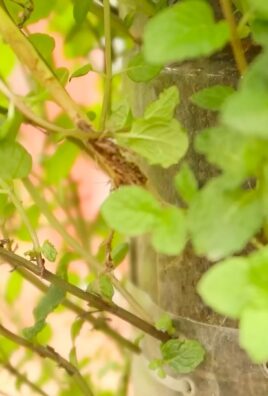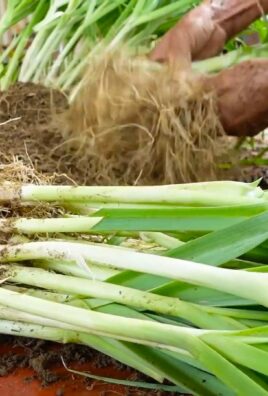Growing corn in a concrete yard might sound like an impossible dream, right? But trust me, it’s absolutely achievable, and I’m here to show you how! Forget the sprawling fields of Iowa; we’re bringing the taste of summer to your urban oasis with these clever DIY tricks. For centuries, corn has been a staple crop, deeply woven into the cultures of the Americas, providing sustenance and playing a vital role in traditions. Now, even if you’re surrounded by concrete, you don’t have to miss out on the joy of harvesting your own sweet, juicy corn.
In today’s world, where access to fresh, locally grown produce can be limited, and grocery bills are constantly rising, learning how to cultivate your own food, even in a small space, is more important than ever. This DIY guide is your ticket to fresh corn on the cob, right from your own backyard (or, in this case, concrete yard!). We’ll explore simple, effective methods for growing corn in a concrete yard, using containers, raised beds, and other creative solutions. Get ready to transform your space and enjoy the satisfaction of homegrown goodness!

Corn Cultivation on a Concrete Patio: A DIY Project for Urban Gardeners
Hello, dear garden friends! Who says you need a garden to harvest fresh corn? Today, I’ll show you how you can successfully grow corn even on a concrete patio. It’s easier than you think, and the result is simply delicious! Let’s start this exciting DIY project together.
What you need: The Material List
Before we get started, here is a list of all the materials and tools you will need for this project:
- Large Planters: Choose planters with a capacity of at least 50 liters per plant. The bigger, the better! I recommend using containers with a diameter of at least 45 cm and a depth of 50 cm.
- High-Quality Potting Soil: Use a well-draining potting soil that is rich in nutrients. You can also mix in compost or organic fertilizer to enrich the soil further.
- Corn Kernels: Buy high-quality seeds from a trusted source. Make sure the variety is suitable for growing in pots. There are special varieties that grow more compactly.
- Fertilizer: A slow-release fertilizer or a liquid fertilizer for vegetables is ideal. I like to use an organic fertilizer to be environmentally friendly.
- Watering Can or Garden Hose: For regularly watering your corn plants.
- Trowel: For filling the planters and planting the corn kernels.
- Support Material (optional): Bamboo stakes or similar to support the plants if needed. This can be very helpful, especially in strong winds.
- Drainage Material: Gravel, expanded clay, or clay shards to prevent waterlogging.
- Mulch (optional): Straw, wood chips, or grass clippings to retain moisture in the soil and suppress weeds.
The Preparation: The Foundation for Your Success
Good preparation is the be-all and end-all for successful corn cultivation. Here are the steps you should follow:
- Choose the right planters: As mentioned, large planters are crucial. They provide the roots with enough space to grow and ensure good stability for the plants. Make sure the containers have drainage holes so that excess water can run off.
- Create drainage: Fill the bottom of the planters with a layer of drainage material (approx. 5-10 cm). This prevents waterlogging, which can lead to root rot.
- Prepare the soil: Mix the potting soil with compost or organic fertilizer. This ensures a good supply of nutrients for the plants. Fill the planters with the prepared soil to just below the rim.
- Choose the location: Corn needs a lot of sun! Choose a location that gets at least 6-8 hours of sun per day. a spot sheltered from the wind is also advantageous to protect the plants from damage.
Sowing: The Beginning of Growth
Now comes the exciting part: sowing the corn kernels!
- Prepare the corn kernels: You can soak the corn kernels in lukewarm water for a few hours before sowing. This speeds up germination.
- Sow the kernels: Press small holes (approx. 2-3 cm deep) into the soil with your finger. Place 2-3 corn kernels in each hole. This increases the likelihood that at least one kernel will germinate.
- Close the holes: Cover the corn kernels with soil and press down lightly.
- Water: Water the soil gently so that it is well-moistened. Avoid washing out the kernels.
- Wait and watch: Place the planters in the chosen location and wait patiently for germination. This can take a few days to weeks, depending on the temperature and variety.
Care: Ensuring Your Corn Thrives
Proper care is crucial for your corn to grow healthy and produce a bountiful harvest.
- Regular watering: Corn needs a lot of water, especially during the growth and flowering periods. Water the plants regularly so that the soil is always moist but not wet. On hot days, it may be necessary to water daily.
- Fertilizing: Fertilize the plants regularly with a slow-release fertilizer or a liquid fertilizer for vegetables. Start fertilizing as soon as the plants are a few centimeters high. Follow the instructions on the fertilizer package.
- Remove weeds: Regularly remove weeds from the planters. Weeds compete with the corn for nutrients and water.
- Supporting: As the plants get taller, it may be necessary to support them with bamboo stakes or similar. This prevents them from tipping over in strong winds.
- Assisting pollination: Corn is wind-pollinated. If you only have a few plants, it may be useful to assist pollination manually. To do this, gently shake the plants when the male flowers (the tassels at the top of the plant) are releasing pollen. You can also transfer the pollen to the female flowers (the ears) with a brush.
Protection from Pests and Diseases
Pests and diseases can also occur on a concrete patio. Here are some tips on how to protect your corn plants:
- Aphids: Aphids can be washed off with a jet of water or controlled with a biological insecticide.
- Corn borer: The corn borer is a moth whose caterpillars develop in the stalks and ears of the corn. You can manually remove the caterpillars or use a biological insecticide.
- Fungal diseases: Fungal diseases can be caused by too high humidity or waterlogging. Ensure good ventilation and avoid wetting the leaves when watering. If necessary, you can use a fungicide.
- Birds: Birds can eat the young corn kernels. Protect the plants with a net or a scarecrow.
The Harvest: The Reward for Your Effort
After about 80-100 days (depending on the variety), the time has finally come: the corn cobs are ripe and can be harvested!
- Recognizing ripeness: The corn cobs are ripe when the husks are brown and dry and the corn kernels look plump and juicy. You can also break open a kernel and check if it is milky.
- Harvesting the cobs: Carefully break the corn cobs off the plants.
- Preparing the cobs: You can cook, grill, or roast the corn cobs immediately. They taste best when they are fresh. You can also cut the kernels off the cob and freeze or dry them.
Additional Tips for Successful Corn Cultivation on a Concrete Patio
Be patient: Growing corn takes time and patience. Don’t be discouraged if it doesn’t work out right away. With a little practice, you will soon be bringing in a bountiful harvest.
Choose the right variety: There are special corn varieties that are suitable for growing in pots. These varieties are more compact and bear fruit earlier.
Pay attention to crop rotation: Do not grow corn in the same location every year. Rotate the plants to avoid depleting the soil on one side.
Use mulch: Mulch helps to retain moisture in the soil and suppress weeds.

Conclusion
So, there you have it! Transforming your barren concrete yard into a thriving corn patch might seem like a far-fetched dream, but with this simple DIY trick, it’s entirely within reach. We’ve shown you how to bypass the limitations of traditional gardening and cultivate delicious, homegrown corn, even without access to a traditional garden bed. This method isn’t just about growing corn; it’s about reclaiming your space, embracing sustainability, and enjoying the unparalleled satisfaction of harvesting food you’ve nurtured from seed to stalk.
Why is this DIY approach a must-try? Because it democratizes gardening. It empowers anyone, regardless of their living situation, to connect with nature and experience the joy of growing their own food. It’s a cost-effective solution, utilizing readily available materials and minimizing the need for expensive gardening equipment. And, perhaps most importantly, it’s a testament to human ingenuity and our ability to adapt and thrive in any environment.
Beyond the basic method outlined, there’s plenty of room for experimentation and personalization. Consider these variations to tailor the process to your specific needs and preferences:
* Container Size: While we’ve suggested specific container sizes, feel free to adjust them based on the space you have available and the variety of corn you’re growing. Smaller containers might be suitable for dwarf corn varieties, while larger containers will provide more room for root development for taller, more robust plants.
* Soil Amendments: Enhance your soil mix with additional amendments like compost tea, worm castings, or bone meal to provide your corn plants with an extra boost of nutrients. These organic additions can significantly improve soil fertility and promote healthy growth.
* Companion Planting: Introduce companion plants like beans or squash to your containers. These plants can help improve soil health, deter pests, and even provide shade for the corn roots. Research compatible pairings to maximize the benefits.
* Vertical Support: For taller corn varieties, consider adding vertical support structures like bamboo stakes or trellises to prevent the stalks from toppling over in windy conditions. This will ensure that your plants remain upright and healthy throughout the growing season.
* Watering System: If you live in a particularly hot or dry climate, consider setting up a simple drip irrigation system to ensure that your corn plants receive consistent moisture. This will help prevent drought stress and promote optimal growth.
This DIY corn growing method is more than just a gardening hack; it’s a gateway to a more sustainable and fulfilling lifestyle. Imagine the taste of freshly picked, homegrown corn, knowing that you cultivated it yourself in the heart of your concrete jungle. The pride and satisfaction are simply unmatched.
So, what are you waiting for? Gather your supplies, follow our simple steps, and embark on your own concrete corn-growing adventure. We’re confident that you’ll be amazed by the results. And once you’ve harvested your first crop, we encourage you to share your experiences with us! Post photos of your thriving corn plants, share your tips and tricks, and let us know what worked best for you. Together, we can inspire others to embrace the joy of urban gardening and transform their concrete spaces into vibrant, productive oases. Let’s prove that even in the most unlikely of places, the magic of growing your own food can flourish. This DIY corn growing method is a game changer!
Frequently Asked Questions (FAQ)
1. What type of corn is best suited for growing in containers in a concrete yard?
The best corn varieties for container gardening are typically shorter, more compact types. Look for varieties labeled as “dwarf” or “container-friendly.” Some popular choices include:
* ‘On Deck’ Corn: This variety is specifically bred for container growing and produces small, manageable plants with good yields.
* ‘Golden Bantam’ Corn: A classic heirloom variety that is relatively short and adaptable to container environments.
* ‘Trinity’ Corn: An early-maturing variety that is well-suited for shorter growing seasons and container gardening.
* ‘Blue Hopi’ Corn: A beautiful and nutritious variety that is drought-tolerant and can thrive in containers with proper care.
When selecting a variety, consider your local climate and growing season. Choose a variety that is known to mature quickly and is well-suited to the conditions in your area.
2. How much sunlight does container-grown corn need?
Corn requires at least 6-8 hours of direct sunlight per day to thrive. Choose a location in your concrete yard that receives ample sunlight throughout the day. If you don’t have a spot that gets full sun, you may need to supplement with grow lights, especially during the early stages of growth. Rotate the containers regularly to ensure that all sides of the plants receive adequate sunlight.
3. What is the best soil mix for growing corn in containers?
A well-draining and nutrient-rich soil mix is essential for successful container gardening. A good starting point is a mix of:
* 1/3 high-quality potting soil
* 1/3 compost (for nutrients and water retention)
* 1/3 perlite or vermiculite (for drainage)
You can also add slow-release fertilizer to the mix to provide a steady supply of nutrients throughout the growing season. Avoid using garden soil in containers, as it can become compacted and poorly drained.
4. How often should I water my container-grown corn?
Corn is a thirsty plant, especially when grown in containers. Water deeply and regularly, especially during hot and dry weather. Check the soil moisture daily and water when the top inch feels dry to the touch. Avoid overwatering, as this can lead to root rot. A good rule of thumb is to water until water drains out of the bottom of the container.
5. How do I fertilize my container-grown corn?
Corn is a heavy feeder and requires regular fertilization to produce a good yield. Use a balanced fertilizer (e.g., 10-10-10) every 2-3 weeks, following the instructions on the fertilizer package. You can also supplement with organic fertilizers like compost tea or fish emulsion. Avoid over-fertilizing, as this can burn the roots.
6. How do I pollinate my corn plants if they are grown in containers?
Corn is wind-pollinated, so you may need to assist with pollination if your plants are grown in a sheltered location. When the tassels (male flowers) appear at the top of the plant, gently shake the stalks to release pollen. You can also collect pollen from the tassels and dust it onto the silks (female flowers) that emerge from the developing ears of corn. Repeat this process for several days to ensure adequate pollination.
7. How do I know when my corn is ready to harvest?
Corn is typically ready to harvest about 20-25 days after the silks first appear. The silks will turn brown and dry, and the kernels will be plump and milky when pierced with a fingernail. To test for ripeness, peel back a portion of the husk and check the kernels. If they are ready, the juice will be milky and the kernels will be tightly packed.
8. Can I grow other vegetables in the same container as my corn?
Companion planting can be beneficial for corn. Good companion plants include beans (which fix nitrogen in the soil), squash (which provides ground cover and helps retain moisture), and herbs like basil and oregano (which can deter pests). Avoid planting corn with tomatoes or brassicas (e.g., cabbage, broccoli), as they can compete for nutrients.
9. What are some common pests and diseases that affect corn, and how can I prevent them?
Common pests of corn include corn earworms, aphids, and spider mites. Diseases include corn smut and leaf blight. To prevent pests and diseases, practice good sanitation, provide adequate air circulation, and monitor your plants regularly. Use organic pest control methods like insecticidal soap or neem oil if necessary. Choose disease-resistant varieties whenever possible.
10. Can I reuse the soil from my corn containers for other plants?
Yes, you can reuse the soil from your corn containers, but it’s important to amend it with fresh compost and fertilizer to replenish the nutrients that were used by the corn plants. You may also want to sterilize the soil to kill any potential pests or diseases. This can be done by baking the soil in the oven at 200°F for 30 minutes or by solarizing it in a black plastic bag for several weeks.





Leave a Comment